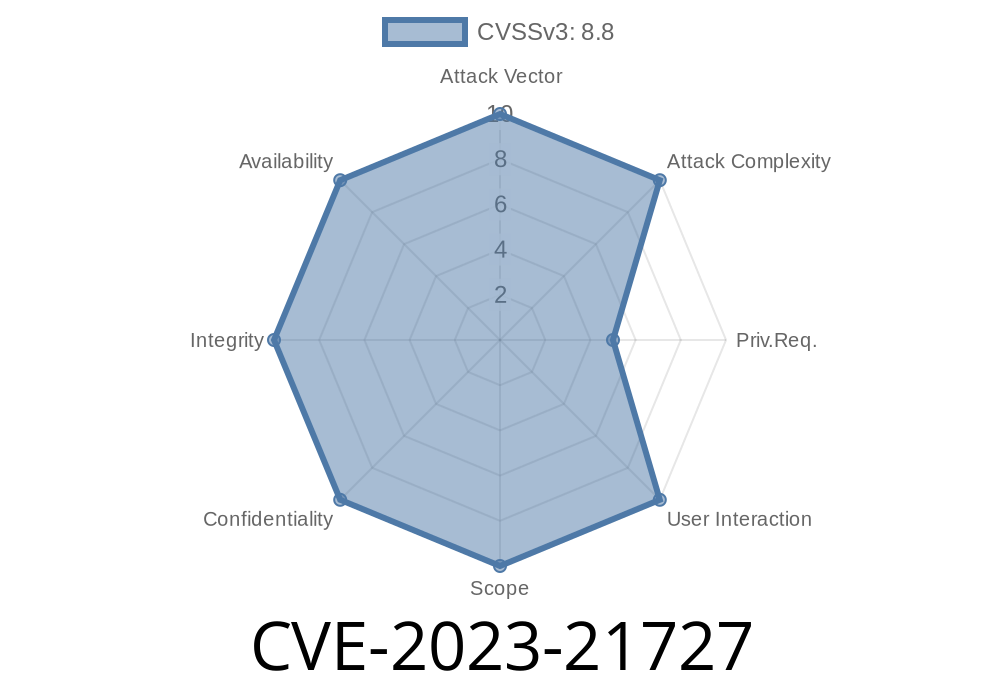Remote code execution vulnerabilities are always a big deal, but when one hits a critical service like Microsoft's Remote Procedure Call (RPC) runtime, it's especially alarming. In this article, we'll take a close and simple look at CVE-2023-21727, a serious vulnerability that gave attackers a potentially easy way to gain full access to a target Windows machine—all remotely. Here you'll find code snippets, a look at how the exploit works, and references for further detail.
What is CVE-2023-21727?
CVE-2023-21727 is a remote code execution (RCE) flaw found in Microsoft’s RPC runtime. The vulnerability allows unauthenticated attackers to execute arbitrary code on vulnerable Windows systems. Microsoft classified this issue as "Critical" and assigned it a CVSS score of 8.8.
Windows 11
- Windows Server 2016/2019/2022
Patch release: January 2023 Patch Tuesday (KB5022282)
What's Remote Procedure Call (RPC)?
RPC is a protocol used by Windows to let applications communicate with each other, even across networks. Services like file sharing, user logins, and printer management depend on it.
What Went Wrong?
The vulnerability lies in the way the Windows RPC runtime handles specially crafted requests. An attacker can send a malicious RPC request to a vulnerable machine, leading to memory corruption and potentially allowing code execution as the RPC service (often running with SYSTEM privileges).
How Could it Be Exploited?
An attacker only needs network access to the target's RPC endpoint (usually port 135/TCP) and no valid credentials.
They send a crafted RPC request to the server.
3. The vulnerable server mishandles the request, corrupts memory, and allows the attacker's injected code to run.
Proof of Concept (PoC): Simplified Example
*Note: Releasing full exploit code before most systems are patched is irresponsible and against most platforms’ rules, so we share only snippets to illustrate the logic.*
Below is a simplified Python snippet using the impacket library to reach the vulnerable endpoint. This is for educational demo only!
from impacket.dcerpc.v5 import transport, srvs
from impacket.dcerpc.v5.dtypes import NULL
# Target RPC server
target_ip = '192.168.1.100'
username = 'attacker'
password = 'password'
# Create transport binding to RPC endpoint
string_binding = r'ncacn_np:%s[\pipe\svcctl]' % target_ip
rpctransport = transport.DCERPCTransportFactory(string_binding)
rpctransport.set_credentials(username, password)
dce = rpctransport.get_dce_rpc()
dce.connect()
dce.bind(srvs.MSRPC_UUID_SRVS)
# Send specially crafted payload (hypothetical)
malicious_buffer = b"A" * 2048 # Contents would be the real exploit data
try:
# assume 'NetrShareEnum' could trigger the memory corruption
resp = srvs.hNetrShareEnum(dce, NULL, 1)
except Exception as e:
print(f"Error executing RPC call: {e}")
dce.disconnect()
*(This code does NOT exploit CVE-2023-21727 directly, but shows how attackers interact with RPC)*
Transparency: Exploitation is "more likely" according to Microsoft.
- Mitigations: Firewall rules (block 135/TCP), network segmentation, patching immediately.
Where to Learn More
- Microsoft Advisory for CVE-2023-21727
- Microsoft Patch details (KB5022282)
- Official Impacket library for RPC interaction
- Windows RPC Protocol documentation
- NVD: CVE-2023-21727 Summary
Update ASAP: Apply the latest Windows security updates on all machines.
- Restrict RPC Access: Use firewalls to block 135/TCP and other remote management ports from untrusted networks.
Network segmentation: Ensure only trusted systems can reach RPC endpoints.
- Monitor: Watch for abnormal connections to port 135/TCP and scan internal assets frequently.
Conclusion
CVE-2023-21727 underscores the ongoing danger posed by exposed Windows services on the network. An unpatched RPC runtime can hand an attacker the keys to the kingdom without ever needing to log in. If you administer or use Windows systems, patch now—don’t wait for attackers to find you.
Timeline
Published on: 04/11/2023 21:15:00 UTC
Last modified on: 04/19/2023 16:05:00 UTC
